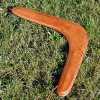Definition: (noun) A place where bees and beehives are kept, especially a place where bees are raised for their honey.
Synonyms: bee house.
Usage: She had started her apiary with a small capital, a book of practical hints, and a second-hand queen.
Discuss
Source: The Free Dictionary
 Malarchuk is a retired Canadian professional ice hockey goaltender who played in the National Hockey League from 1981 to 1992. He is perhaps best known for sustaining a life-threatening injury during a 1989 game, when two players collided in front of his goal, and one of the players’ skate blades slashed Malarchuk’s internal carotid artery. Remarkably, Malarchuk was able to skate off the ice despite bleeding heavily. He survived because his team’s athletic trainer, a former army medic, did what?
Malarchuk is a retired Canadian professional ice hockey goaltender who played in the National Hockey League from 1981 to 1992. He is perhaps best known for sustaining a life-threatening injury during a 1989 game, when two players collided in front of his goal, and one of the players’ skate blades slashed Malarchuk’s internal carotid artery. Remarkably, Malarchuk was able to skate off the ice despite bleeding heavily. He survived because his team’s athletic trainer, a former army medic, did what?  In 1992, the
In 1992, the .jpg) Marceau was a French actor and mime who gained renown in 1947 with the creation of Bip, a sad, white-faced clown with a tall, battered hat—reminiscent of Charlie Chaplin’s Tramp. Noted for his eloquent, deceptively simple portrayals, he earned worldwide acclaim in the 1950s with his production of the “mimodrama” of Nikolai Gogol’s Overcoat. In 1978, he founded a school of mimodrama in Paris. How did Marceau’s miming help save children from the Nazis during World War II?
Marceau was a French actor and mime who gained renown in 1947 with the creation of Bip, a sad, white-faced clown with a tall, battered hat—reminiscent of Charlie Chaplin’s Tramp. Noted for his eloquent, deceptively simple portrayals, he earned worldwide acclaim in the 1950s with his production of the “mimodrama” of Nikolai Gogol’s Overcoat. In 1978, he founded a school of mimodrama in Paris. How did Marceau’s miming help save children from the Nazis during World War II?  The boomerang is a sickle-shaped throwing stick used mainly by the Aborigines of Australia. Its arms are slightly curved, and when it is thrown, the boomerang generally follows an arc-shaped trajectory. Recreational boomerangs often travel along a circular path and return to the thrower, but other, larger versions do not return and are used in hunting and warfare. What famous king owned a collection of boomerangs more than 3,000 years ago?
The boomerang is a sickle-shaped throwing stick used mainly by the Aborigines of Australia. Its arms are slightly curved, and when it is thrown, the boomerang generally follows an arc-shaped trajectory. Recreational boomerangs often travel along a circular path and return to the thrower, but other, larger versions do not return and are used in hunting and warfare. What famous king owned a collection of boomerangs more than 3,000 years ago?  Founded in Iran in the mid-19th century by Baha’ Ullah, Bahá’í is a religion based on the unity of all faiths. Adherents pray daily, fast 19 days a year, and follow a strict ethical code. Because of the religion’s 19 initial disciples, the number 19 is considered sacred, and the Bahá’í calendar, which began in 1844, consists of 19 months of 19 days, with four additional “intercalary” days. Today is the first day of the 168th year of the Bahá’í Era. On what day does the Bahá’í week begin?
Founded in Iran in the mid-19th century by Baha’ Ullah, Bahá’í is a religion based on the unity of all faiths. Adherents pray daily, fast 19 days a year, and follow a strict ethical code. Because of the religion’s 19 initial disciples, the number 19 is considered sacred, and the Bahá’í calendar, which began in 1844, consists of 19 months of 19 days, with four additional “intercalary” days. Today is the first day of the 168th year of the Bahá’í Era. On what day does the Bahá’í week begin?  In Japan, where the
In Japan, where the